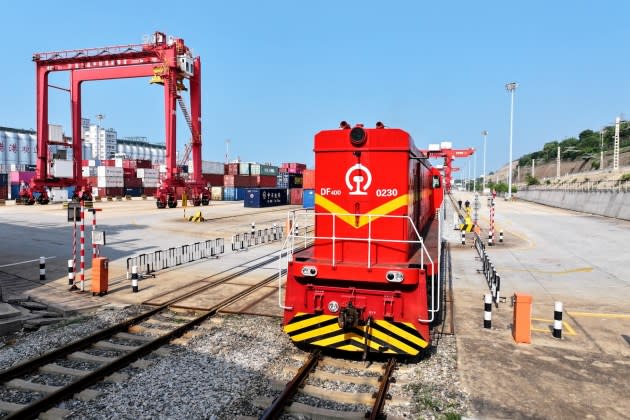
The ongoing onslaught of Houthi attacks on commercial vessels in the Red Sea led to soaring ocean freight rates throughout much of 2024 as ocean carriers rerouted ships around southern Africa. But the added costs and delays stemming from the crisis are now prodding more European shippers to turn to rail as an alternative to secure product from one of their top trading partners.
Over the first six months of this year, China-to-Europe rail freight volumes have jumped 11 percent year over year to 1.23 million 20-foot equivalents (TEUs) moved, according to data from China State Railway Group. In the first half, 11,403 trains were dispatched, up 12 percent from the prior-year period.
More from Sourcing Journal
July marked the third consecutive month in which more than 1,700 trains made the journey between China and Europe, with 1,776 transporting roughly 185,000 TEUs.
A recently published report from DHL Global Forwarding indicates that rates on the westbound China-to-Europe route are increasing amid the high demand.
According to June data from China-based freight forwarder VipuTrans, transporting a 40-foot container from Zhengzhou to Paris via rail costs $9,200, while sending it to Hamburg costs $7,000. A Zhengzhou-to-Milan journey costs $9,400.
DHL says the ideal booking window for rail freight out of China remains 10 to 14 days before the train’s estimated time of departure. A standard terminal-to-terminal transit time takes 20 days to get to Poland, and 22 days to reach Germany. The logistics giant said in its report that it highly recommending shippers to start forecasting demand throughout the peak shipping season, especially before the Chinese Golden Week from Oct. 1-7.
More European shippers opting to use rail shouldn’t be surprising, particularly given the transportation mode is faster than its ocean counterpart.
Estimates from global logistics services provider Dimerco indicate that rail service from Xi’an in central China could take anywhere from 13 to 25 days to get to Europe, depending on the destination. In comparison, Dimerco says ocean freight would have a voyage between 35 and 50 days depending on both the origin and destination ports.
According to Dimerco, rail rates would range between 15 and 25 percent higher on a given trip, but noted that any cost delta could be offset by avoiding ocean surcharges and penalties. Additionally, the logistics services provider noted that the faster transit times enable lower inventory and can make it easier to win and keep customers.
The DHL report notes that there remains congestion on the main corridor at China-Kazakhstan border crossings due to volumes and customs inspections. The company says terminal departure delays from China hubs in Xi’an and Chengdu have improved. While transit times are extended, rail remains the fastest solution to move containers from China to Europe, DHL says.
The growth of the China-Europe trade lane is mainly driven by service upgrades, such as a full-time schedule—further incentivizing shippers that don’t want to deal with longer detours associated with the Red Sea crisis.
Unlike the previous model under which local railway departments set separate running times, a full-time schedule means the arrival and departure times as well as the routes are fixed in each section.
According to China Railway, 17 trains run weekly, connecting major trade hubs such as Chengdu and Guangzhou to Duisburg in Germany, and Lodz in Poland, operating on a passenger train-like schedule.
The Red Sea dilemma isn’t the only reason a shift to rail has become more prevalent, with the Chinese government also having been rapidly developing rail services in the wake of Russia’s invasion of Ukraine. This has meant that Chinese rail operators created more new “middle corridor” routes that travel through Russia’s southern neighbors like Kazakhstan.
In June, the China-Europe Railway Express has launched the first, direct express freight train line from Shanghai to Düsseldorf and Neuss, Germany. The launch of the service, which departs from Shanghai every Saturday on a fixed schedule, provides a new logistics channel for high value-added and time-sensitive goods. The westbound trip would take 20 days.
A month later, the railway launched another service line, this time originating in the east coast city of Lianyungang, before crossing Kazakhstan, the Caspian Sea, Azerbaijan and Georgia en route to Europe.
EMEA Tribune is not involved in this news article, it is taken from our partners and or from the News Agencies. Copyright and Credit go to the News Agencies, email news@emeatribune.com Follow our WhatsApp verified Channel





